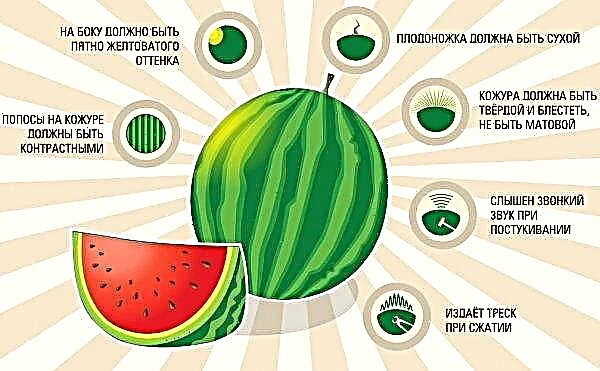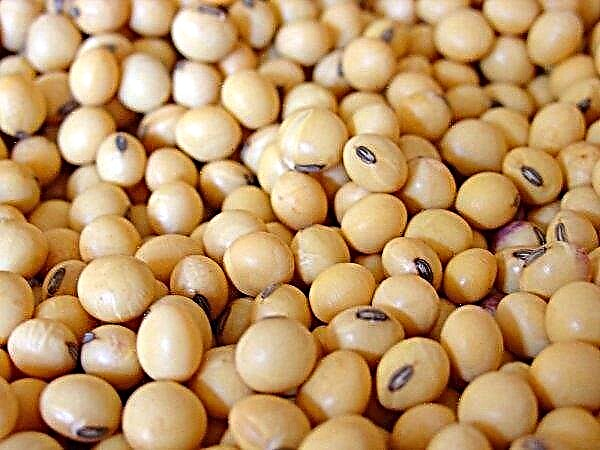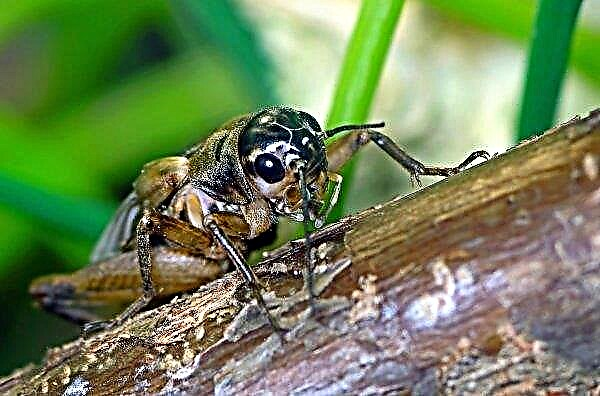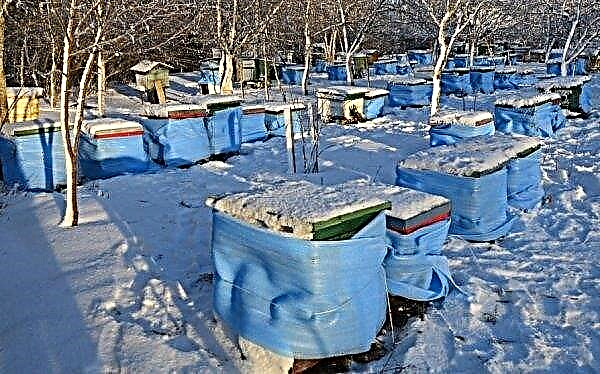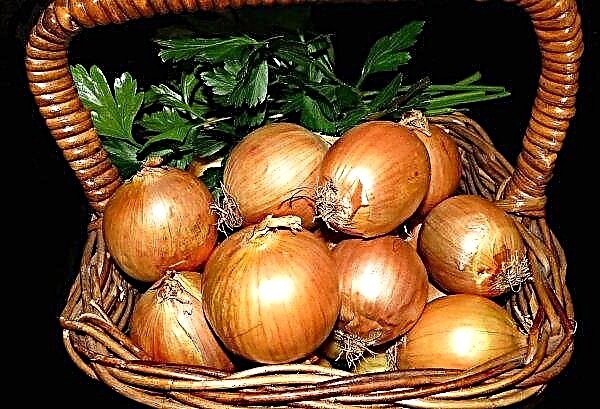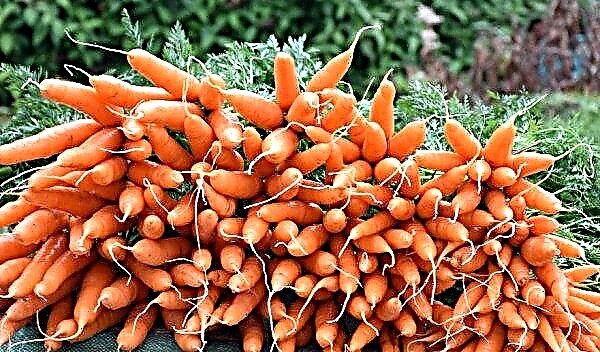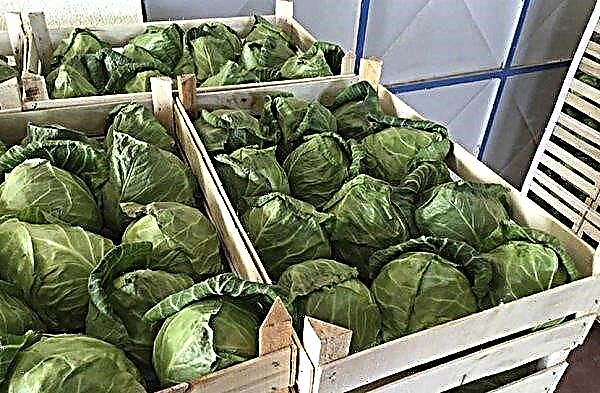Peppers, like tomatoes, are very popular and are grown in almost every garden, almost all year round present in the diet of people. But these plants are very sensitive to growing conditions. In this article we will try to figure out what causes such a frequent phenomenon as curl of pepper leaves.
Why pepper curls leaves: main reasons
One of the reasons for this phenomenon may be improper care of plantings, an attack of pests or the development of a disease. Before proceeding to save the crop, it is necessary to correctly determine what happened to the plants, and only after that take action.
Growth anomalies
Herbicides are sometimes responsible for leaf folding. Fighting weeds between rows, the grower must be careful when spraying them: before starting work, make sure that there is no wind, and the herbicides will not be on the stems and leaves of pepper. Compost and mulch, which in the past were treated with a herbicide, can also damage plants.
Important! If the pepper bush survives infection with herbicides, then, despite tissue damage and stunted growth, it will yield a small crop.
Improper care
Environmental problems are often reflected on pepper leaves, usually in the form of a folded sheet leaf boat.
In some cases, the response to leaf curl is produced by healthy plants:
- On hot days, in the middle of summer, plants often experience physiological stress, hot winds in combination with low humidity cause a protective reaction of the plant - a decrease in the area for moisture evaporation.
- Peppers give the same reaction to a strong temperature increase in the greenhouse (above + 28 ° C), in this case, not only the leaves curl, but the pollen in the peduncles becomes sterile, and they fall off without forming an ovary. In hot climates or on sandy soil, poorly retaining moisture, planting pepper may need more frequent watering. The mulch laid below (at the base of the stem) will help to delay the evaporation of water from the soil and prevent leaf folding.
- Strong leaf-forming pruning of the bush can also lead to leaf twisting, as a result of which plants get stress. Avoid removing too many leaves or stems at a time and instead prune the bush for several days, giving time for restoration.
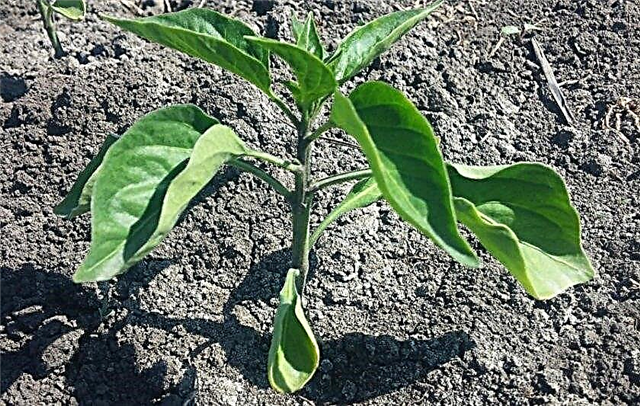
- Sometimes folded leaves reflect the shock that has arisen in immature seedlings after transplantation. It is necessary to avoid disturbance of the root system during a pepper transplant and transplant the plants to a permanent place on a cloudy day, thereby minimizing the shock from the transplant. With proper watering, peppers after transplanting quickly recover and straighten the leaves.
- The same reaction can occur after installing support pegs in the base of the root system or weeding too deeply. If the damage to the roots is not too severe, the plants quickly repair the damage and increase the additional root mass.
- Too much water or its stagnation in clay soil can also lead to curling, but the leaves usually remain green. Peppers grow best in soil that remains uniformly moist; for this, approximately 1.5–2 L of water is required to be poured under the root of the plant once a week. In case of lack of moisture, the oldest, lower leaves on the plant are usually the first to curl up, before deformation they become thicker in the center or turn yellow.
Did you know? The nutritional value of pepper depends on its color. Red pepper is a beta-carotene "bomb", it contains a large amount of vitamin C and is useful for skin, visual acuity and maintaining the cornea of the eye. Green-colored vegetables have the smallest number of calories (15 kcal per 100 g), therefore they are recommended for diet and the diet of expectant mothers, since they contain folic acid and youth vitamin (E). Yellow and orange colors indicate a high content of B vitamins, lutein and minerals: iron, calcium, potassium and magnesium.
Diseases
In sweet and bitter peppers, viral diseases often lead to twisted leaves and other symptoms, depending on the virus. Pest insects spread viruses between plants, spreading the disease.
Viral curliness, common in regions with a humid climate, causes lightening or yellowing of leaves and rapid growth of fine leaf mass in combination with curled foliage. Mosaic virus causes the leaves to become spotty and curled.
Sometimes leaf folding indicates the development of fungal diseases:
- Powdery mildew - makes the leaves of pepper spin and can weaken the bush to such an extent that the fruits on it cannot ripen normally. The first signs that the pepper is sick are white or gray spots on the underside of the leaf, later the leaves turn yellow and begin to curl.
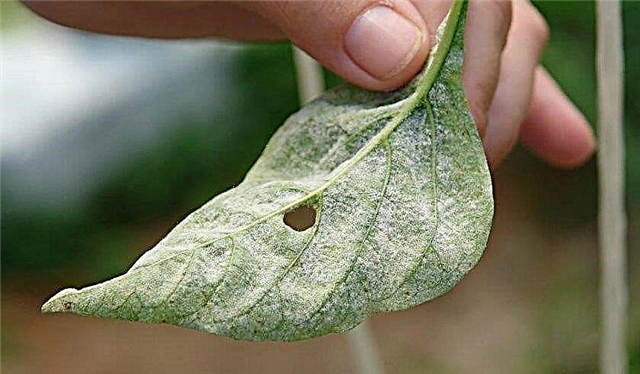
- Gray rot - The cause is the development of fungal spores Botrytis cinerea. As a first symptom, moist brown spots appear on the stem at the junction with the soil. Further brown spots are covered with a whitish-gray coating of mycelium.
An outbreak of the disease is provoked by prolonged wet weather in combination with heat (above + 20 ° C). Sick peppers are uprooted and taken out of the garden, the remaining plants are treated with fungicides.Important! The likelihood of viral diseases on pepper beds can be minimized by sterilizing garden tools in an antiseptic solution (10% bleach with Belizna chlorine and 90% water).
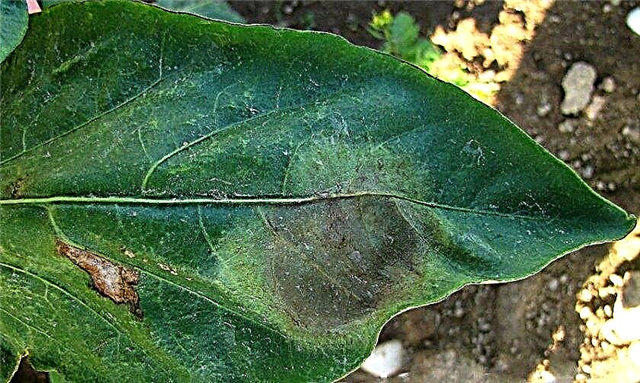
- Blight (Phytophthora infestans) - A very dangerous disease for the nightshade family, in the first stage the symptoms are similar to the development of the black leg. After a couple of weeks, brown strokes and spots cover the plant tissues (fruits, leaves and branches). In wet weather, the affected tissues quickly rot, and in the heat they mummify. At the first signs of late blight, soil and plants should be treated with fungicides.

Pests
Folding leaves of bell peppers and bitter peppers can be a manifestation of various problems, ranging from pests and viruses to stress from the environment. Twisting is often caused by pests such as aphids, thrips and spider mites. These insects feed on plant sap, pulling it out of the leaves, thereby causing them to curl, dry out or fall off.
Spider mite
Spider mites (Tetranychus urticae) - small insects that feed on the sap of plants, they are poorly visible to the naked eye. If you look closely, you can see them in the form of tiny moving points at the base of the stem. Spider mites feel good on plants that regularly experience water stress (irregular watering, lack or excess of water). A spider mite often populates bushes of indoor decorative peppers, which owners rarely remember about watering, after which they fill the soil with water to dirt.
Symptoms of a spider mite lesion:
- the leaves turn yellow, sometimes they may seem bronze;
- a weightless web covers the leaves and stalks of pepper;
- leaves turn yellow and fall from the bush.
Important! If the leaves are curled only in response to the heat, sprinkling of plantings in the middle of the day is recommended, this will help keep the plant tissue in a comfortable cool.
Aphid
Peach Aphid (Myzus persicae) - tiny insects whose body size is from 0.8 to 1.5 mm. They feed on juice and plant cells. The dominance of aphids on pepper leads to the death of leaves, the appearance of necrotic spots, a decrease in yield, the appearance of ugly fruits and stunted shoots. Aphids secrete a sticky, sweet substance called honey dew, which creates a breeding ground for the development of fungal diseases.
Symptoms
- pests in the set are located on the bottom of the leaf plates or on the stems of plants;
- aphids are usually green or yellow, but may be pink, brown, red or black, depending on the species;
- along with aphids on the bushes you can always see ants that bring insects to plants and protect them in the future.
What to do and how to process peppers
If adult peppers folded leaves, you should immediately examine the plants and determine the cause of their poor health. In case of lack of nutrients, it is necessary to carry out root dressing or fertilizer on the leaf without delay. If a viral disease is detected, the foci of infection are removed from the beds and treated with special drugs against fungal diseases. Opponents of the use of chemistry on vegetables treat garden plants from pests and diseases with biological preparations, various infusions and decoctions of herbs.
Fertilizer beds
Twisting the upper leaves can cause nitrogen deficiency in the soil. In this case, it is necessary to analyze the soil for nitrogen level and apply the required amount of fertilizer necessary to eliminate the problem. The fastest way to apply nitrogen to the soil is with liquid root dressings.
Video: Causes of curling leaves of pepper
There are several options for liquid root nitrogen fertilizing:
- With ammonia. To 10 liters of water add 3 tbsp. l pharmacy ammonia, mix well and quickly poured under the roots of plants. To feed a bush of pepper requires at least 1 liter of solution.
- Infusion of fermented nettle. Such an infusion is done in advance, in large containers, usually in early summer. If you store the finished infusion under a closed lid, it does not lose its beneficial properties for a long time. A large garden barrel or other container is filled up to half with fresh nettle and added to the top with water, then closed with a lid and left in the sun for fermentation. The contents of the barrel are mixed daily. This is done so that carbon dioxide formed during fermentation is released. After 10-12 days, the concentrated fertilizer is ready for use. Dilute the concentrate immediately before fertilizing the pepper. On a 10-liter bucket add 1 liter of nettle concentrate, after which they pour 1-2 liters under each bush.
- Bird droppings. Half a 10-liter bucket is filled with fresh or dry poultry (chicken, pigeon) droppings, added to the top with water, mixed contents, tightly closed with a lid and left for a week for fermentation in the sun. Naturally, it is advisable to put fertilizer for fermentation on the street, because a fetid odor is released during the process. The result is a concentrated fertilizer in the form of green slurry. Before feeding, it must be diluted with water (add 10 liters of slurry to 10 liters of water).
Did you know? Dishes with hot pepper should not be washed down with water, as this will only enhance the burning effect in the esophagus. It is recommended to drink a glass of fat milk, eat ice cream or a spoonful of vegetable oil.
Pest management
Insects can be destroyed by spraying insecticides. Processing is carried out as pests are detected, best in the evening, when the ambient temperature drops below + 27 ° C. When spraying the drug, it is necessary to carefully treat the tops and bottom of the leaves from the bottom up. If necessary, the leaves that are especially populated by the pest are turned over for ease of processing, which is repeated after a few days until the presence of aphids or ticks is detected on the plants.
How to destroy pests:
- Aphid. If aphid population is limited to only a few leaves or shoots, then these fragments can be trimmed and removed. They fight large colonies of the pest, washing them off with a strong stream of water from the bushes or treating the plantings with insecticides: Fury, Furanon, Actellik, etc. Along with the destruction of aphids, the gardener needs to take care of the destruction of ant colonies near the beds. To do this, a poisonous or sticky bait is laid out in the garden and near the anthill. If this is not done, the ants will again bring the aphids to the pepper.
- Spider mite. On small beds of pests, you can wash them off the pepper bushes with a strong stream of water. Massively infected plants are treated with insecticides: Actellik, Fitoverm, Neoron, Akarin, Apollo, etc.
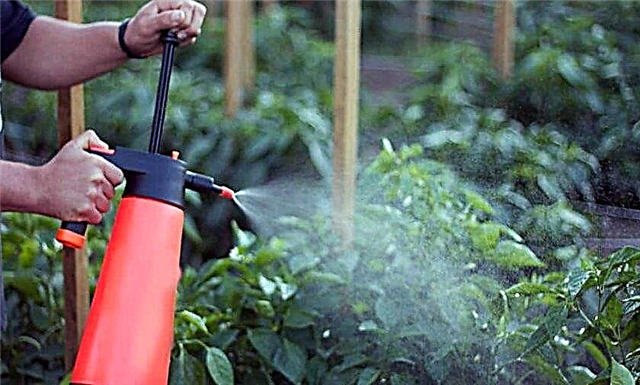
You can fight pests and folk remedies.
Onion broth
A decoction of this vegetable not only fights against aphids, but also prevents the appearance of some fungal diseases on plants.
Cooking:
- Finely chop about 75 g of onion.
- Bring 10 l of water to a boil.
- Add chopped onions to boiling water and simmer for 30 minutes over low heat.
- Cool the broth and spray it on the plants inhabited by aphids.
Garlic has a sharp and not too pleasant smell that lasts a long time. The aphid does not tolerate the garlic smell, so this infusion is very effective.
Cooking:
- Garlic (500-600 g) is passed through a press.
- Chopped garlic is added to a container with 10 l of water.
- The mixture is left to infuse for about a day.
- Ready infusion is sprayed or watered on the planting sheet.
Dandelion brothDid you know? Vitamin C contained in paprika is resistant to decomposition during heat treatment (boiling, baking or drying).
A decoction of the flowers of this common plant is one of the most effective home methods for controlling aphids and spider mites.
Cooking:
- It is necessary to collect 40 yellow dandelion heads.
- Bring 10 l of water to a boil.
- Pour dandelion flowers into boiling water and simmer for 3 hours.
- After the broth cools naturally, they are sprayed with plants affected by spider mites or aphids.
Disease treatment
There is no cure for viral diseases. To prevent the spread of the disease, it is necessary to dig up and destroy the infected plants in the fire. Viruses usually do not live in the soil, so if such a nuisance happens at the beginning of the growing season, you can plant another stem of pepper in an empty place.
Fungicides used to treat fungal diseases on solanaceous crops:
- "Fundazole";
- "Acrobat Ordan";
- "Speed";
- Previkur;
- "Ridomil Gold";
- Fitosporin-M.
Preventative measures
Most fungal diseases are easier to prevent than to subsequently cure plants, therefore, in order to prevent the planting of peppers, they are treated several times with copper-containing preparations. The first treatment is carried out a month after transplanting seedlings to a permanent place (in the garden, in the greenhouse). Each subsequent treatment with fungicides is carried out with an interval of 14 days. Usually 3 preventive treatments are carried out, but in some cases, when fungal diseases occur, a fourth treatment is also carried out. They process plantings by spraying on a sheet.
Biological agents can also be used as prophylaxis. For example, to catch a few dozen ladybugs (red and yellow) in a meadow and plant them in infected aphid plants. Ladybugs are natural aphid predators, so the pest population will quickly decline.
The emergence of fungal diseases experienced gardeners prevent preventive foliar treatments of plantings:Did you know? Paprika acts on the human body as a strong diuretic and lowers high blood pressure in the circulatory system.
- a solution of water and milk (1 liter of milk is added to 10 liters of water);
- undiluted whey.
When pepper is grown on a site with low-lying soil water and natural waterlogging, irrigation is reduced to a minimum or they can be dispensed with altogether.In this case, you can also grow vegetables in high beds, which will provide good drainage.

Additional Pepper Growing Tips
General recommendations for growing bell pepper:
- this culture requires at least 10 hours of exposure to direct sunlight;
- when planting, it is necessary to observe the distance between the bushes so that air circulates freely;
- it is advisable to tie the fruit-bearing pepper to the support so that the stems do not break due to strong winds or due to the heavy load of the poured fruits;
- for good bush development and abundant fruiting, the soil in the basal layer should always remain uniformly moist;
- pepper likes well-fertilized soil, but too much nitrogen in the soil is undesirable, as this can contribute to the formation of a chic bush on which there will be practically no fruit;
- the acidity of the soil for the cultivation of solanaceous must have a pH from 6.0 to 6.5;
- the soil in the beds with peppers is mulched with a thick layer (at least 10-15 cm), this will help to maintain soil moisture and protect the root system from overheating;
- the removal of early flowers in the future will contribute to the formation of large peppers and higher overall yields.






